Thermographic Imaging in Cultural Heritage: A Short Review
Abstract
1. Introduction
2. PT and/or Passive IRT Applications
2.1. Documentary Materials
2.2. Panel Paintings and Marqueteries
2.3. Mosaics
3. Conclusions
Funding
Institutional Review Board Statement
Informed Consent Statement
Data Availability Statement
Acknowledgments
Conflicts of Interest
References
- Sfarra, S.; Fernandes, H.C.; López, F.; Ibarra-Castanedo, C.; Zhang, H.; Maldague, X. Qualitative assessments via infrared vision of sub-surface defects present beneath decorative surface coatings. Int. J. Thermophys. 2018, 39, 13. [Google Scholar] [CrossRef]
- Venegas, P.; Perán, J.; Usamentiaga, R.; De Ocáriz, I.S. NDT Inspection of Aeronautical Components by Projected Thermal Diffusivity Analysis. Quant. Infrared Thermogr. J. 2021, 18, 34–49. [Google Scholar] [CrossRef]
- Schramm, S.; Osterhold, P.; Schmoll, R.; Kroll, A. Combining modern 3D reconstruction and thermal imaging: Generation of large-scale 3D thermograms in real-time. Quant. Infrared Thermogr. J. 2021, in press. [CrossRef]
- Liu, K.; Huang, K.-L.; Sfarra, S.; Yang, J.; Liu, Y.; Yao, Y. Factor analysis thermography for defect detection of panel paintings. Quant. Infrared Thermogr. J. 2021, in press. [CrossRef]
- Tao, N.; Wang, C.; Zhang, C.; Sun, J. Quantitative measurement of cast metal relics by pulsed thermal imaging. Quant. Infrared Thermogr. J. 2020, 19, 27–40. [Google Scholar] [CrossRef]
- Garrido, I.; Lagüela, S.; Fang, Q.; Arias, P. Introduction of the combination of thermal fundamentals and Deep Learning for the automatic thermographic inspection of thermal bridges and water-related problems in infrastructures. Quant. Infrared Thermogr. J. 2022, in press. [CrossRef]
- Kim, C.; Park, G.; Jang, H.; Kim, E.-J. Automated classification of thermal defects in the building envelope using thermal and visible images. Quant. Infrared Thermogr. J. 2022, in press. [CrossRef]
- Deane, S.; Avdelidis, N.P.; Ibarra-Castanedo, C.; Williamson, A.A.; Withers, S.; Zolotas, A.; Maldague, X.P.V.; Ahmadi, M.; Pant, S.; Genest, M.; et al. Development of a thermal excitation source used in an active thermographic UAV platform. Quant. Infrared Thermogr. J. 2022, in press. [CrossRef]
- Suchan, D.; Hendorfer, G. Thermal effusivity determination of carbon fibre-reinforced polymers by means of active thermography. Quant. Infrared Thermogr. J. 2020, 17, 210–222. [Google Scholar] [CrossRef]
- Larbi Youcef, M.H.A.; Feuillet, V.; Ibos, L.; Candau, Y. In situ quantitative diagnosis of insulated building walls using passive infrared thermography. Quant. Infrared Thermogr. J. 2022, 19, 41–69. [Google Scholar] [CrossRef]
- Freni, F.; Quattrocchi, A.; Piccolo, S.A.; Montanini, R. Quantitative evaluation of eggs freshness using flash thermography. Quant. Infrared Thermogr. J. 2019, 17, 13–25. [Google Scholar] [CrossRef]
- Chudzik, S. Quality inspection of natural leather using non-destructive testing technique. Quant. Infrared Thermogr. J. 2020, 17, 249–267. [Google Scholar] [CrossRef]
- Minkina, W. Theoretical basics of radiant heat transfer—Practical examples of calculation for the infrared (IR) used in infrared thermography measurements. Quant. Infrared Thermogr. J. 2021, 18, 269–282. [Google Scholar] [CrossRef]
- Altenburg, S.J.; Straße, A.; Gumenyuk, A.; Maierhofer, C. In-situ monitoring of a laser metal deposition (LMD) process: Comparison of MWIR, SWIR and high-speed NIR thermography. Quant. Infrared Thermogr. J. 2022, 19, 97–114. [Google Scholar] [CrossRef]
- Müller, D.; Netzelmann, U.; Valeske, B. Defect shape detection and defect reconstruction in active thermography by means of two-dimensional convolutional neural network as well as spatiotemporal convolutional LSTM network. Quant. Infrared Thermogr. J. 2020, 19, 126–144. [Google Scholar] [CrossRef]
- Yang, X.; Chen, B.; Hu, G.; Wang, X.; Fang, W.; Zhang, J.; Tao, N.; Yuan, G. Pulsed infrared thermographic study of a Chinese Bronze Lei. Herit. Sci. 2022, 10, 152. [Google Scholar] [CrossRef]
- Tortora, M.; Sfarra, S.; Chiarini, M.; Daniele, V.; Taglieri, G.; Cerichelli, G. Non-destructive and micro-invasive testing techniques for characterizing materials, structures and restoration problems in mural paintings. Appl. Surf. Sci. 2016, 387, 971–985. [Google Scholar] [CrossRef]
- Zhang, T.; Zhang, X. A novel algorithm for infrared image contrast enhancement based on neutrosophic sets. Quant. Infrared Thermogr. J. 2021, 18, 344–356. [Google Scholar] [CrossRef]
- Fleuret, J.; Ebrahimi, S.; Ibarra-Castanedo, C.; Maldague, X. Application of blind image quality assessment metrics to pulsed thermography. Quant. Infrared Thermogr. J. 2022, in press. [CrossRef]
- Yoon, S.T.; Park, J.C.; Cho, Y.J. An experimental study on the evaluation of temperature uniformity on the surface of a blackbody using infrared cameras. Quant. Infrared Thermogr. J. 2022, 19, 172–186. [Google Scholar] [CrossRef]
- Bond, W.; Panicker, V.; McMillan, J.; Simpson, R.; Hayes, M.; Machin, G.; Casarosa, G.; Etchells, J. A metrology enabled thermal imager for thermal vacuum testing. Quant. Infrared Thermogr. J. 2022, in press. [CrossRef]
- Vavilov, V.; Karabutov, A.; Chulkov, A.; Derusova, D.; Moskovchenko, A.; Cherepetskaya, E.; Mironova, E. Comparative study of active infrared thermography, ultrasonic laser vibrometry and laser ultrasonics in application to the inspection of graphite/epoxy composite parts. Quant. Infrared Thermogr. J. 2020, 17, 235–248. [Google Scholar] [CrossRef]
- Simmen, K.; Buch, B.; Breitbarth, A.; Notni, G. Non-destructive inspection system for MAG welding processes by combining multimodal data. Quant. Infrared Thermogr. J. 2021, 18, 1–17. [Google Scholar] [CrossRef]
- Ftikou, P.Ε.; Theodorakeas, Ε.; Cheilakou, Μ.; Koui. Long-Term and Sustainable Approach to Preserve Ancient Mosaic Heritage: The Case Study of Mosaic Pavement Located at the “Sanctuary of Pan,” Pnyka (Athens). In Proceedings of the 10th International Symposium on the Conservation of Monuments in the Mediterranean Basin, MONUBA-SIN 2017; Koui, M., Zezza, F., Kouis, D., Eds.; Springer: Cham, Switzerland, 2018; pp. 105–113. [Google Scholar] [CrossRef]
- Ftikou, P.E.; Theodorakeas, E.; Cheilakou, M.; Koui. Non-Destructive techniques (NDT) as rapid and cost-efficient tools for mosaic conservation. In Proceedings of the 12th Conference of the International Committee for the Conservation of Mosaics (ICCM), Sardinia, Italy, 27–31 October 2014. [Google Scholar]
- Ftikou, E. Criteria for the Selection of Materials and Techniques for the Conservation of Historic Mosaics Substrate. Ph.D. Thesis, National Technical University of Athens, Athens, Greece, 2016. [Google Scholar]
- Gavrilov, D.; Maeva, E.; Grube, O.; Vodyanoy, I.; Maev, R. Experimental Comparative Study of the Applicability of Infrared Techniques for Non-destructive Evaluation of Paintings. J. Am. Inst. Conserv. 2013, 52, 48–60. [Google Scholar] [CrossRef]
- Gavrilov, D.; Maeva, E.; Maev, R.G. Thermographic inspection in the service of art science: Theory, methods and considerations. Insight-Non-Destr. Test. Cond. Monit. 2014, 56, 131–136. [Google Scholar] [CrossRef]
- Peeters, J.; Van der Snickt, G.; Sfarra, S.; Legrand, S.; Ibarra-Castanedo, C.; Janssens, K.; Steenackers, G. IR reflectog-raphy and active thermography on artworks; the added value of the 1.5–3 μm band. Appl. Sci. 2018, 8, 50. [Google Scholar] [CrossRef]
- Sfarra, S.; Regi, M. Wavelet analysis applied to thermographic data for the detection of sub-superficial flaws in mosaics. EPJ Appl. Phys. 2016, 74, 31001. [Google Scholar] [CrossRef]
- Shrestha, R.; Sfarra, S.; Ridolfi, S.; Gargiulo, G.; Kim, W. A numerical–thermal–thermographic NDT evaluation of an ancient marquetry integrated with X-ray and XRF surveys. J. Therm. Anal. 2021, 147, 2265–2279. [Google Scholar] [CrossRef]
- Hu, J.; Zhang, H.; Sfarra, S.; Gargiulo, G.; Avdelidis, N.P.; Zhang, M.; Yang, D.; Maldague, X. Non-destructive imaging of marqueteries based on a new infrared-terahertz fusion technique. Infrared Phys. Technol. 2022, 125, 104277. [Google Scholar] [CrossRef]
- Martorana, R.; Capizzi, P. Joint investigation with ground penetrating radar and infrared thermography as a diagnostic support for the restoration of two wall mosaics in the Church of St. Mary of the Admiral in Palermo, Italy. Heritage 2022, 5, 2298–2314. [Google Scholar] [CrossRef]
- Scientific Investigation of Copies, Fakes and Forgeries; Craddock, P., Ed.; Butterworth-Heinemann: Oxford, UK, 2009; 640p, ISBN 978-0-7506-4205-7. [Google Scholar]
- Gavrilov, D.; Maev, R.G.; Almond, D.P. A review of imaging methods in analysis of works of art: Thermographic imag-ing method in art analysis. Can. J. Phys. 2014, 92, 341–364. [Google Scholar] [CrossRef]
- Zhang, H.; Sfarra, S.; Saluja, K.; Peeters, J.; Fleuret, J.; Duan, Y.; Fernandes, H.; Avdelidis, N.; Ibarra-Castanedo, C.; Maldague, X. Non-destructive investigation of paintings on canvas by continuous wave terahertz imaging and flash thermography. J. Nondestruct. Eval. 2017, 36, 34. [Google Scholar] [CrossRef]
- Paoloni, S.; Mercuri, F.; Orazi, N.; Caruso, G.; Zammit, U. Photothermal approach for cultural heritage research. J. Appl. Phys. 2020, 128, 180904. [Google Scholar] [CrossRef]
- Orazi, N. Mid-wave Infrared Reflectography and Thermography for the Study of Ancient Books: A Review. Stud. Conserv. 2020, 65, 437–449. [Google Scholar] [CrossRef]
- Mercuri, F.; Paoloni, S.; Cicero, C.; Zammit, U.; Orazi, N. Infrared emission contrast for the visualization of subsurface graphical features in artworks. Infrared Phys. Technol. 2018, 89, 223–230. [Google Scholar] [CrossRef]
- Sfarra, S.; Regi, M.; Tortora, M.; Casieri, C.; Perilli, S.; Paoletti, D. A multi-technique nondestructive approach for characterizing the state of conservation of ancient bookbindings. J. Therm. Anal. 2018, 132, 1367–1387. [Google Scholar] [CrossRef]
- Tortora, M.; Sfarra, S.; Casieri, C. NMR Relaxometry and IR Thermography to Study Ancient Cotton Paper Bookbinding. Appl. Sci. 2019, 9, 3406. [Google Scholar] [CrossRef]
- Caruso, G.; Paoloni, S.; Orazi, N.; Cicero, C.; Zammit, U.; Mercuri, F. Quantitative evaluations by infrared thermography in optically semi-transparent paper-based artefacts. Measurement 2019, 143, 258–266. [Google Scholar] [CrossRef]
- Sfarra, S.; Theodorakeas, P.; Černecký, J.; Pivarčiová, E.; Perilli, S.; Koui, M. Inspecting Marquetries at Different Wavelengths: The Preliminary Numerical Approach as Aid for a Wide-Range of Non-destructive Tests. J. Nondestruct. Eval. 2017, 36, 6. [Google Scholar] [CrossRef]
- Vavilov, V.P.; Shiryaev, V.V.; Khorev, V.S. Processing of active thermal nondestructive testing results by the method of wavelet analysis. Russ. J. Nondestruct. Test. 2011, 47, 276–283. [Google Scholar] [CrossRef]
- Madruga, F.J.; Ibarra-Castanedo, C.; Conde, O.M.; López-Higuera, J.M.; Maldague, X. Infrared thermography processing based on higher-order statistics. NDT E Int. 2010, 43, 661–666. [Google Scholar] [CrossRef]
- Mercuri, F.; Gnoli, R.; Paoloni, S.; Orazi, N.; Cicero, C.; Zammit, U.; Marinelli, M.; Scudieri, F. Hidden Text Detection by Infrared Thermography / Anwendung der aktiven Infrarotthermographie (IRT) zur Erfassung von verdeckten Texten / Utilisation de la thermographie infrarouge (IRT) pour détecter des textes cachés. Restaur. Int. J. Preserv. Libr. Arch. Mater. 2013, 34, 195–211. [Google Scholar] [CrossRef]
- Duivenvoorden, J.R.; Käyhkö, A.; Kwakkel, E.; Dik, J. Hidden library: Visualizing fragments of medieval manuscripts in early-modern bookbindings with mobile macro-XRF scanner. Herit. Sci. 2017, 5, 6. [Google Scholar] [CrossRef]
- Knox, K.T.; Easton, R.L. Recovery of Lost Writings on Historical Manuscripts with Ultraviolet Illumination. IST Report Window Imaging 2003, 18, 1–5. [Google Scholar]
- Hedjam, R.; Cheriet, M. Historical document image restoration using multispectral imaging system. Pattern Recognit. 2013, 46, 2297–2312. [Google Scholar] [CrossRef]
- Giacometti, A.; Campagnolo, A.; MacDonald, L.; Mahony, S.; Robson, S.; Weyrich, T.; Terras, M.; Gibson, A. The value of critical destruction: Evaluating multispectral image processing methods for the analysis of primary historical texts. Digit. Sch. Humanit. 2015, 32, 101–122. [Google Scholar] [CrossRef]
- Miller, B.F. The feasibility of using thermography to detect subsurface voids in painted wooden panels. J. Am. Inst. Conserv. 1977, 16, 27–35. [Google Scholar] [CrossRef]
- Blessley, K.; Young, C.; Nunn, J.; Coddington, J.; Shepard, S. The Feasibility of Flash Thermography for the Examination and Conservation of Works of Art. Stud. Conserv. 2010, 55, 107–120. [Google Scholar] [CrossRef]
- Moradi, M.; Sfarra, S. Rectifying the emissivity variations problem caused by pigments in artworks inspected by infrared thermography: A simple, useful, effective, and optimized approach for the cultural heritage field. Infrared Phys. Technol. 2021, 115, 103718. [Google Scholar] [CrossRef]
- Ibarra-Castanedo, C.; Sfarra, S.; Ambrosini, D.; Paoletti, D.; Bendada, A.; Maldague, X. Diagnostics of panel paintings using holographic interferometry and pulsed thermography. Quant. Infrared Thermogr. J. 2010, 7, 85–114. [Google Scholar] [CrossRef]
- Yao, Y.; Sfarra, S.; Lagüela, S.; Ibarra-Castanedo, C.; Wu, J.-Y.; Maldague, X.P.; Ambrosini, D. Active thermography testing and data analysis for the state of conservation of panel paintings. Int. J. Therm. Sci. 2018, 126, 143–151. [Google Scholar] [CrossRef]
- Hu, J.; Zhang, H.; Sfarra, S.; Pivarčiová, E.; Yao, Y.; Duan, Y.; Ibarra-Castanedo, C.; Tian, G.; Maldague, X. Autonomous dynamic line-scan continuous-wave terahertz non-destructive inspection system combined with unsupervised exposure fusion. NDT E Int. 2022, 132, 102705. [Google Scholar] [CrossRef]
- Wen, C.-M.; Sfarra, S.; Gargiulo, G.; Yao, Y. Thermographic Data Analysis for Defect Detection by Imposing Spatial Connectivity and Sparsity Constraints in Principal Component Thermography. IEEE Trans. Ind. Inform. 2020, 17, 3901–3909. [Google Scholar] [CrossRef]
- Garrido, I.; Erazo-Aux, J.; Lagüela, S.; Sfarra, S.; Ibarra-Castanedo, C.; Pivarčiová, E.; Gargiulo, G.; Maldague, X.; Arias, P. Introduction of Deep Learning in Thermographic Monitoring of Cultural Heritage and Improvement by Automatic Thermogram Pre-Processing Algorithms. Sensors 2021, 21, 750. [Google Scholar] [CrossRef]
- McCann, D.; Forde, M. Review of NDT methods in the assessment of concrete and masonry structures. NDT E Int. 2001, 34, 71–84. [Google Scholar] [CrossRef]
- Masini, N.; Soldovieri, F. Integrated non-invasive sensing techniques and geophysical methods for the study and conservation of architectural, archaeological and artistic heritage. J. Geophys. Eng. 2011, 8, 083E01. [Google Scholar] [CrossRef]
- Moropoulou, N.P.A.; Avdelidis, E.T.; Delegou, E.; Aggelakopoulou, M.; Karoglou, G.; Haralampopoulos, S.; Griniezakis, M.; Koui, P.; Karmis, A. Aggelopoulos. NDT Investigation on Hagia Sophia Mosaics. In Research Work; NTUA: Athens, Greece, 2000. [Google Scholar]
- Moropoulou, N.P.A.; Avdelidis, E.T.; Delegou, E.; Aggelakopoulou, M.; Karoglou, G.; Haralampopoulos, S.; Griniezakis, M.; Koui, P.; Karmis, A.; Aggelopoulos, A. Investigation for the compatibility of conservation interventions on Hagia Sophia mosaics using NDT techniques. J. Eur. Study Group Phys. Chem. Biol. Math. Tech. Appl. Archaeol. 2000, 59, 103–120. [Google Scholar]
- Theodorakeas, M.P.; Koui. Quantitative infrared thermography for the investigation of plastered mosaics: Comparison of experimental results and numerical modeling. In Proceedings of the 9th International Symposium on the Conservation of Monuments in the Mediterranean Basin, Ankara, Turkey, 3–5 June 2014; pp. 431–445. [Google Scholar]
- Chaban, A.; Deiana, R.; Tornari, V. Wall Mosaics: A Review of On-Site Non-Invasive Methods, Application Challenges and New Frontiers for Their Study and Preservation. J. Imaging 2020, 12, 108. [Google Scholar] [CrossRef] [PubMed]
- Sfarra, S.; Ibarra-Castanedo, C.; Theodorakeas, P.; Avdelidis, N.P.; Perilli, S.; Zhang, H.; Nardi, I.; Koui, M.; Maldague, X.P. Evaluation of the state of conservation of mosaics: Simulations and thermographic signal processing. Int. J. Therm. Sci. 2017, 117, 287–315. [Google Scholar] [CrossRef]
- Daniels, D.J. Ground Penetrating Radar, 2nd ed.; The Institution of Electrical Engineers: London, UK, 2004; pp. 353–656. [Google Scholar]
- Theodorakeas, P.; Avdelidis, N.P.; Cheilakou, E.; Koui, M. Quantitative analysis of plastered mosaics by means of active infrared thermography. Constr. Build. Mater. 2014, 73, 417–425. [Google Scholar] [CrossRef]
- Theodorakeas, P.; Avdelidis, N.P.; Koui, M.; Ibarra–Castanedo, C.; Cheilakou, E.; Bendada, A.; Ftikou, K.; Maldague, X. Active thermographic NDT approaches for the assessment of plastered mosaics. In Proceedings of the 8th International Symposium on the Conservation of Monuments in the Mediterranean Basin- MONUBASIN8, Patras, Greece, 31 May–2 June 2010; Volume 2, pp. 442–456. [Google Scholar]
- Theodorakeas, P.; Ibarra-Castanedo, C.; Sfarra, S.; Avdelidis, N.; Koui, M.; Maldague, X.; Paoletti, D.; Ambrosini, D. NDT inspection of plastered mosaics by means of transient thermography and holographic interferometry. NDT E Int. 2012, 47, 150–156. [Google Scholar] [CrossRef]
- Avdelidis, N.; Koui, M.; Ibarra-Castanedo, C.; Maldague, X. Thermographic studies of plastered mosaics. Infrared Phys. Technol. 2007, 49, 254–256. [Google Scholar] [CrossRef]
- Theodorakeas, P.; Koui, M. Depth Retrieval Procedures in Pulsed Thermography: Remarks in Time and Frequency Domain Analyses. Appl. Sci. 2018, 8, 409. [Google Scholar] [CrossRef]
- Titman, D. Applications of thermography in non-destructive testing of structures. NDT E Int. 2001, 34, 149–154. [Google Scholar] [CrossRef]
- Koui, M.; Avdelidis, N.P.; Theodorakeas, P.; Dritsa, V.; Cheilakou, E. Non-Destructive and Spectroscopic Methods for Material Investigation; Open Academic Editions: Kallipos, Greece, 2015. Available online: http://hdl.handle.net/11419/6168 (accessed on 22 September 2022).
- Kidangan, R.T.; Krishnamurthy, C.V.; Balasubramaniam, K. Detection of dis-bond between honeycomb and composite facesheet of an Inner Fixed Structure bond panel of a jet engine nacelle using infrared thermographic techniques. Quant. Infrared Thermogr. J. 2022, 19, 12–26. [Google Scholar] [CrossRef]
- Groz, M.; Sommier, A.; Abisset, E.; Chevalier, S.; Battaglia, J.; Batsale, J.; Pradere, C. Thermal resistance field estimations from IR thermography using multiscale Bayesian inference. Quant. Infrared Thermogr. J. 2021, 18, 332–343. [Google Scholar] [CrossRef]
- Theodorakeas, P. Quantitative Analysis and Defect Assessment Using Infrared Thermographic Approaches. Ph.D. Thesis, National Technical University of Athens, Athens, Greece, 2013. [Google Scholar]
- Theodorakeas, P.; Cheilakou, E.; Ftikou, E.; Koui, M. Passive and active infrared thermography: An overview of applications for the inspection of mosaic structures. J. Phys. Conf. Ser. 2015, 655, 12061–12070. [Google Scholar] [CrossRef]
- Chung, Y.; Lee, S.; Kim, W. Latest advances in common signal processing of pulsed thermography for enhanced detectability: A review. Appl. Sci. 2021, 11, 12168. [Google Scholar] [CrossRef]
- Yao, Y.; Sfarra, S.; Ibarra-Castanedo, C.; You, R.; Maldague, X.P.V. The multi-dimensional ensemble empirical mode decomposition (MEEMD)—An advanced tool for thermographic diagnosis of mosaics. J. Therm. Anal. Calorim. 2017, 128, 1841–1858. [Google Scholar] [CrossRef]
- Fleuret, J.; Ebrahimi, S.; Ibarra-Castanedo, C.; Maldague, X. On the use of pulsed thermography signal reconstruction based on linear support vector regression for carbon fiber reinforced polymer inspection. Quant. Infrared Thermogr. J. 2022, in press. [CrossRef]
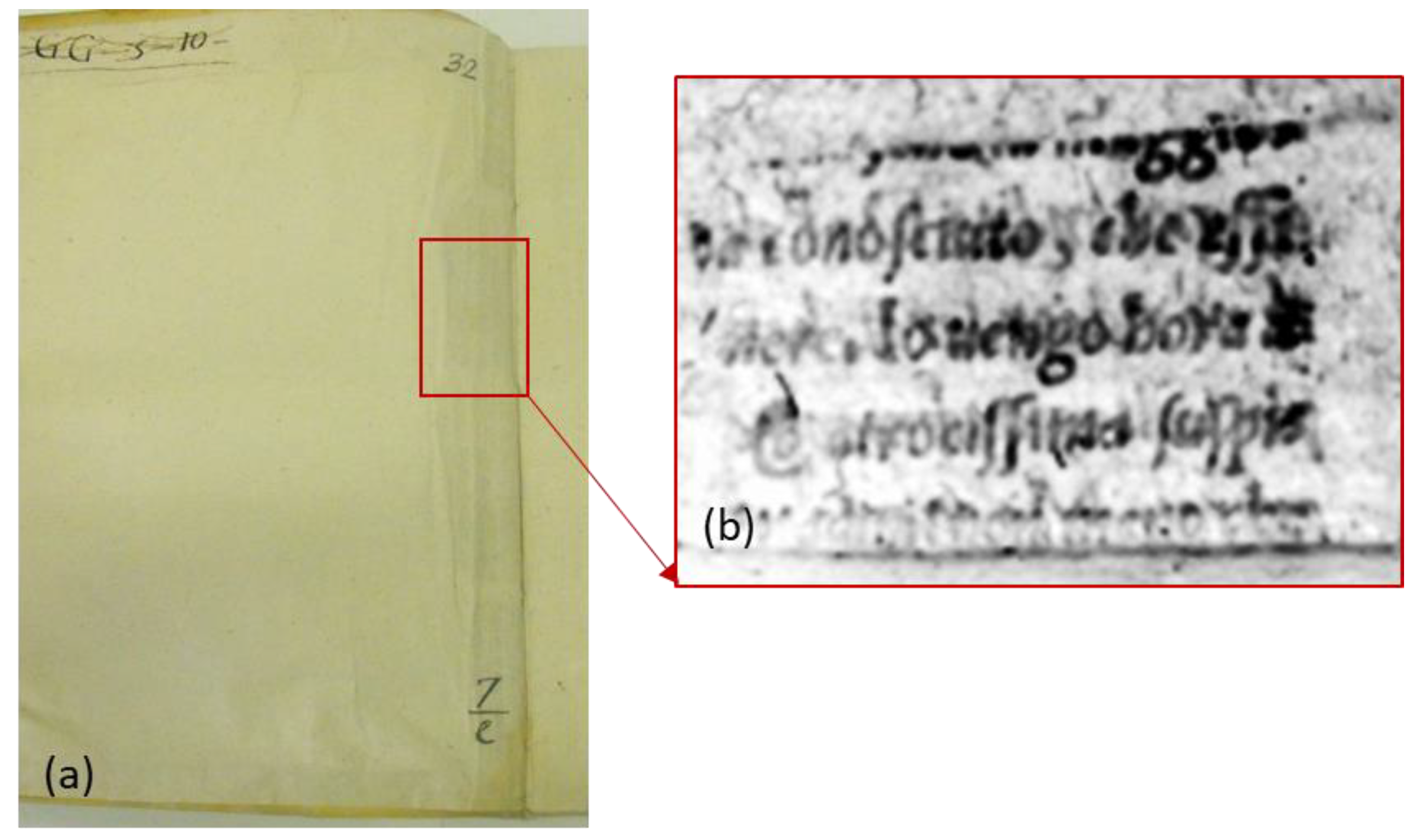

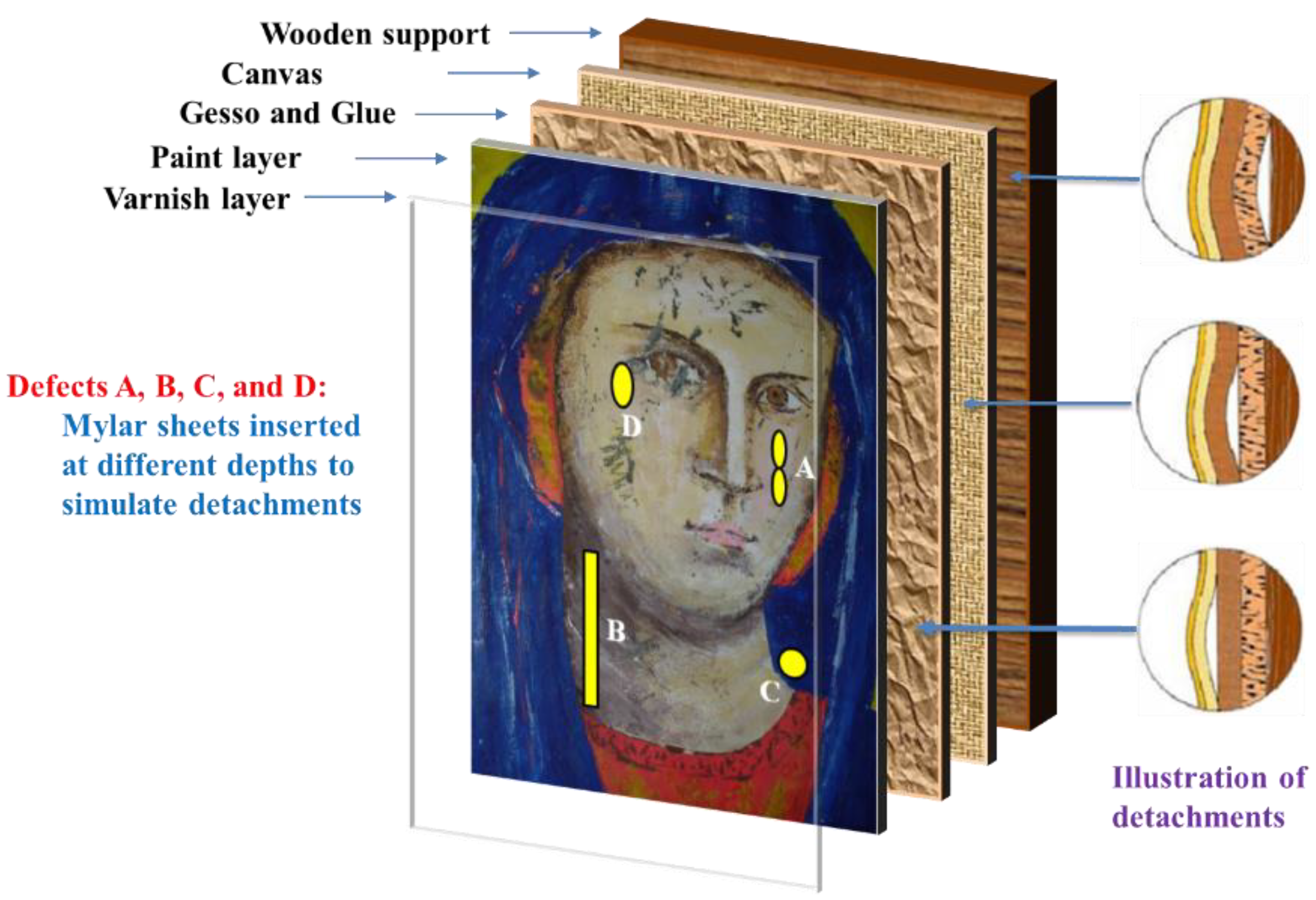




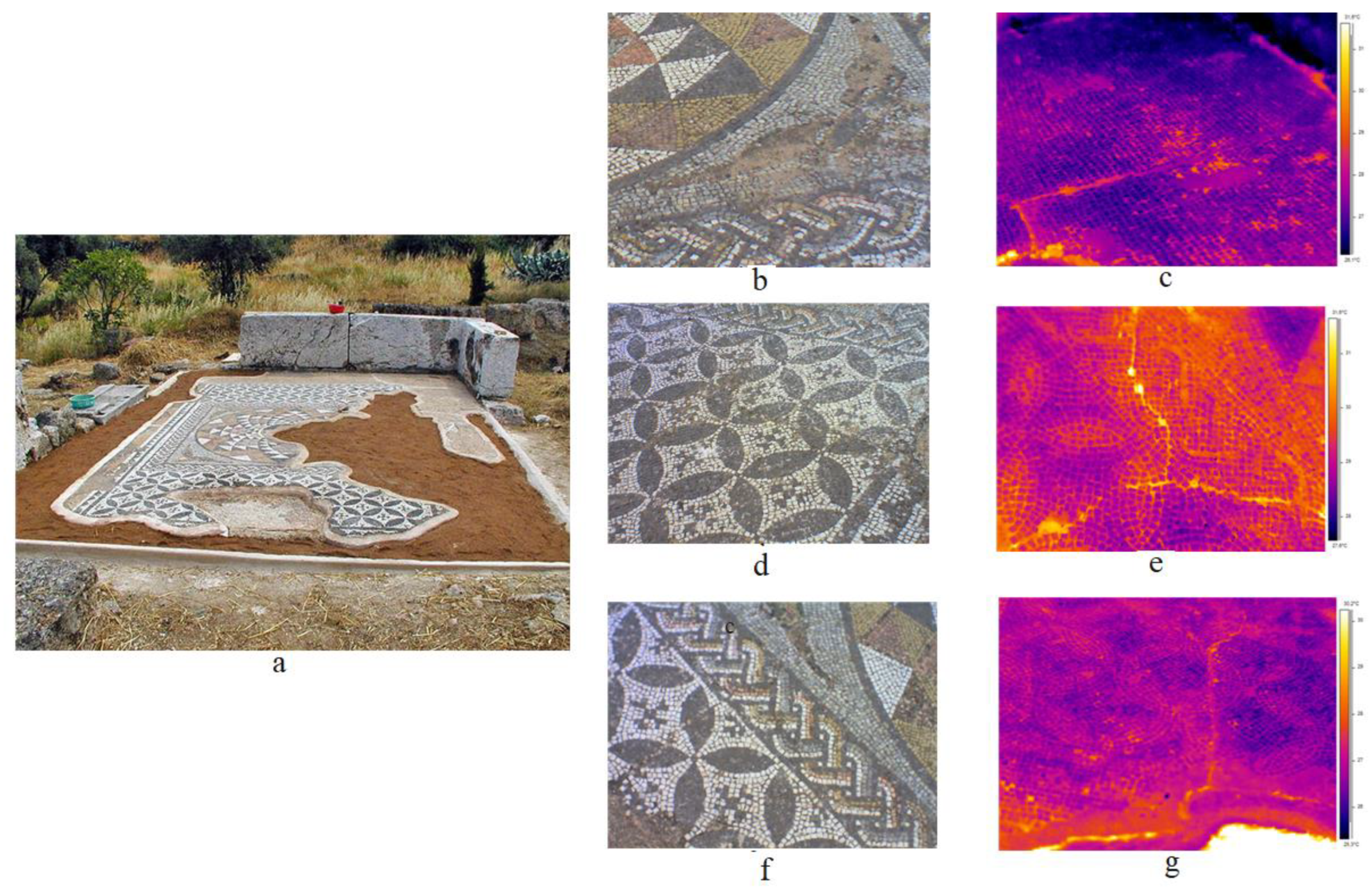


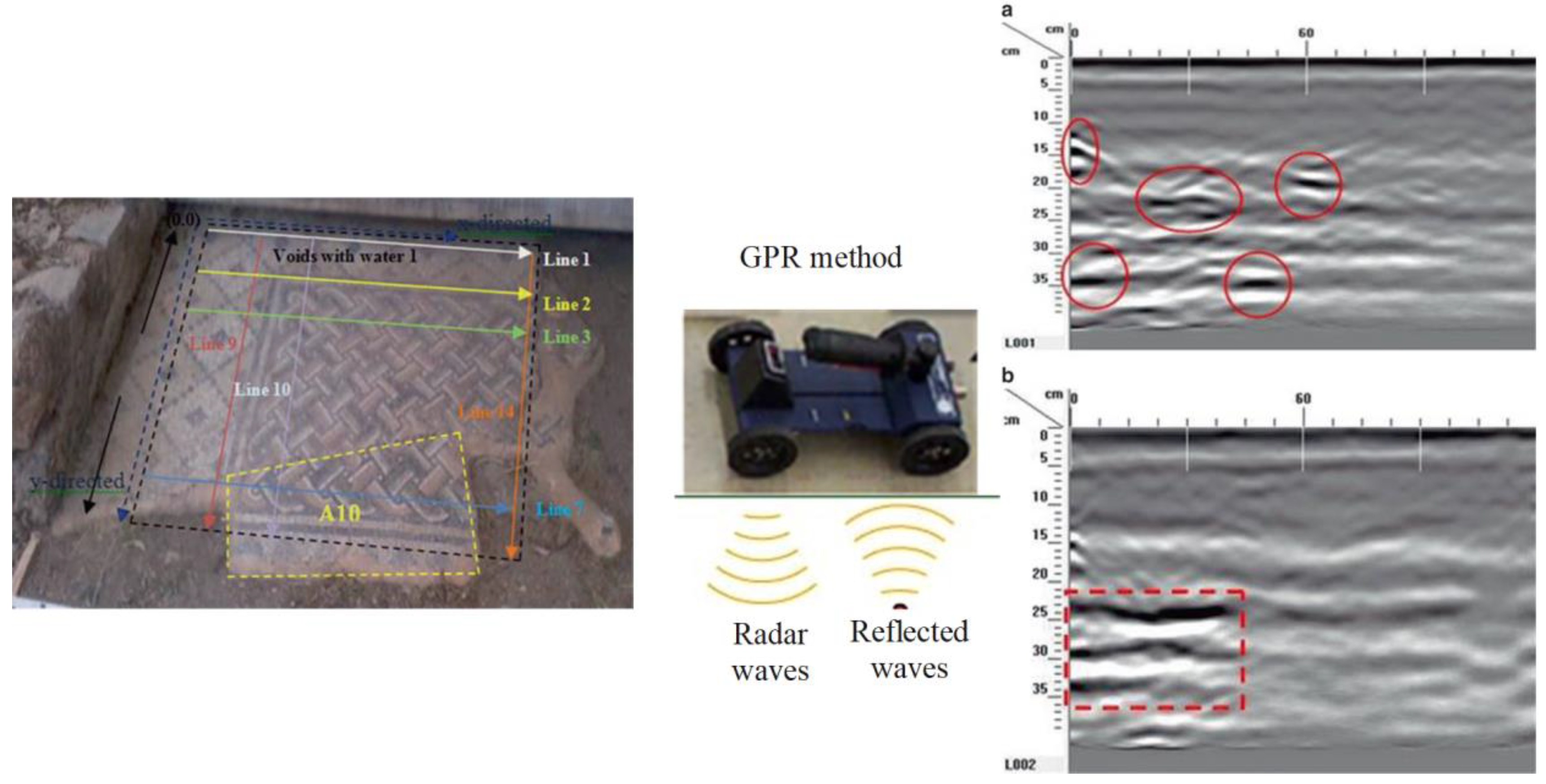
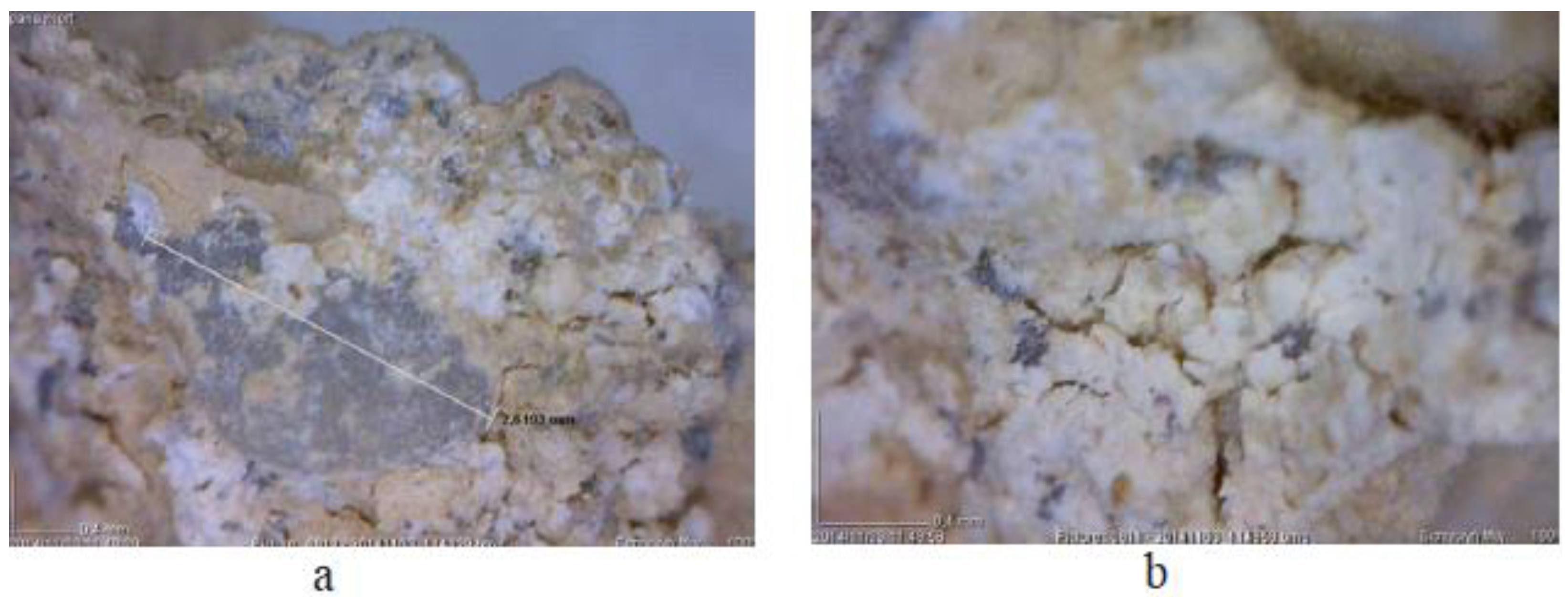
| Feature Inspected | Structure for Scientific Reasons | Identifying Hidden Features (e.g., Underdrawings, Pentimenti, Preparation Layers by Pencil) | Identifying Defects for Subsequent Treatment and Restoration | Identifying Forgery | Identifying Damaged Features | |
|---|---|---|---|---|---|---|
| Artwork | ||||||
| Documentary materials | √ | √ | √ | √ | ||
| Panel paintings | √ | √ | √ | √ | √ | |
| Marqueterie | √ | √ | √ | |||
| Mosaics | √ | √ | √ | |||
Publisher’s Note: MDPI stays neutral with regard to jurisdictional claims in published maps and institutional affiliations. |
© 2022 by the authors. Licensee MDPI, Basel, Switzerland. This article is an open access article distributed under the terms and conditions of the Creative Commons Attribution (CC BY) license (https://creativecommons.org/licenses/by/4.0/).
Share and Cite
Dritsa, V.; Orazi, N.; Yao, Y.; Paoloni, S.; Koui, M.; Sfarra, S. Thermographic Imaging in Cultural Heritage: A Short Review. Sensors 2022, 22, 9076. https://doi.org/10.3390/s22239076
Dritsa V, Orazi N, Yao Y, Paoloni S, Koui M, Sfarra S. Thermographic Imaging in Cultural Heritage: A Short Review. Sensors. 2022; 22(23):9076. https://doi.org/10.3390/s22239076
Chicago/Turabian StyleDritsa, Vasiliki, Noemi Orazi, Yuan Yao, Stefano Paoloni, Maria Koui, and Stefano Sfarra. 2022. "Thermographic Imaging in Cultural Heritage: A Short Review" Sensors 22, no. 23: 9076. https://doi.org/10.3390/s22239076
APA StyleDritsa, V., Orazi, N., Yao, Y., Paoloni, S., Koui, M., & Sfarra, S. (2022). Thermographic Imaging in Cultural Heritage: A Short Review. Sensors, 22(23), 9076. https://doi.org/10.3390/s22239076










